The Spotted Lanternfly in Connecticut
Background for Spotted Lanternfly Quarantine in Connecticut
The Connecticut Agricultural Experiment Station (CAES) has issued a Quarantine Order with defined restricted areas for the exotic pest spotted lanternfly, Lycorma delicatula (SLF for short). This insect has been detected in Connecticut with established populations detected in Fairfield, Litchfield, Hartford, New London, and New Haven Counties and single individuals intercepted in numerous towns. The spotted lanternfly is a new plant pest to the United States and represents a threat to Connecticut’s environment, residential areas, and agricultural interests, particularly forests, orchards, vineyards, and nurseries. The purpose of this quarantine is to slow the spread of SLF within the state and provide for certification of Connecticut businesses for movement of regulated articles out of state and help protect the economic interests of the state’s agricultural industries by suppressing, controlling, or eradicating infestations of spotted lanternfly in regulated areas, and provide by inspection or compliance agreement methods to permit the movement of regulated articles not infested with spotted lanternfly.
The quarantine order was renewed January 1, 2024, and will remain in effect until December 31, 2024, after which the quarantine may be renewed, rescinded by the Director, or replaced by the promulgation of regulations. View the quarantine order by selecting this link: The quarantine order was renewed January 1, 2024, and will remain in effect until December 31, 2024, after which the quarantine may be renewed, rescinded by the Director, or replaced by the promulgation of regulations. View the quarantine order by selecting this link: Spotted Lanternfly Quarantine Order
9/21/2020 - Finding of Spotted Lanternfly in West Haven and Greenwich, CT CAES Press Release
10/15/2019 - Finding of Spotted Lanternfly in Southbury, CT CAES Press Release
Learn How to Identify SLF and What to Do if Found
Why the SLF Is of Such Concern to Connecticut
Trees At Risk and How It Affects Trees
Indications that the SLF May Be Present
Additional Sources of Information
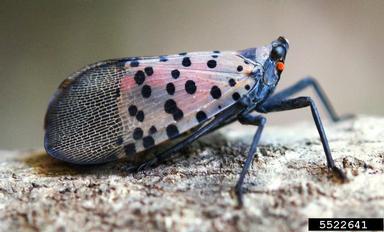
Adult spotted lanternfly
Lawrence Barringer, Pennsylvania Department of Agriculture, Bugwood.org
Basic Biology
Description
The spotted lanternfly (Lycorma delicatula) adult is approximately one inch long and one-half inch wide with large and colorful wings. The front wings of the spotted lanternfly are light brown with black spots in the center. Their hind wings have contrasting patches of red and black with a white band in between. The legs and head are black; the abdomen is yellow with broad black bands.
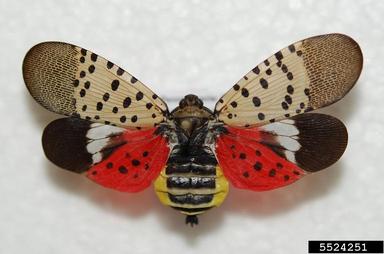
Adult spotted lanternfly showing the fore and hind wings.
Lawrence Barringer, Pennsylvania Department of Agriculture, Bugwood.org
The three immature stages, called nymphs, are black with white spots. During the fourth and final nymphal stage, the developing insect adds red patches and small wing pads. Only the adult stage has wings.
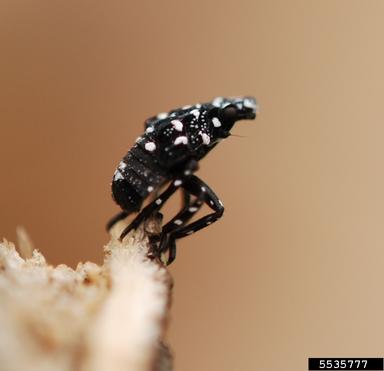
Immature spotted lanternfly
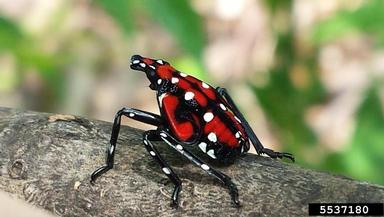
Fourth nymphal stage of immature SLF
Lawrence Barringer, Pennsylvania Department of Agriculture, Bugwood.org
The SLF is a planthopper of the family Fulgoridae, a family known for their bright colors and their pronounced snout-like head structure. SLF is considered to be native to China, India and Vietnam. It can walk, jump, or, as an adult, fly short distances. However it is a hitchhiking insect. It lays eggs on almost any surface, including vehicles, trailers, outdoor equipment, and patio furniture, and can be spread long distances when people move infested material.
Life Cycle
SLF lays its eggs in the fall on smooth host plant surfaces and on non-host material. Bricks, stones, and dead plants can all serve as egg laying sites. Eggs are laid in masses of 30-50 eggs, with the individual eggs yellowish-brown in color. The egg mass itself is covered by a gray, waxy coating that is very indistinct. Eggs hatch in the spring and early summer, and nymphs begin feeding on a wide range of host plants by sucking sap from young stems and leaves. Adults appear in late July and tend to focus their feeding on tree of heaven (Ailanthus altissima) and grapevine (Vitus vinifera).
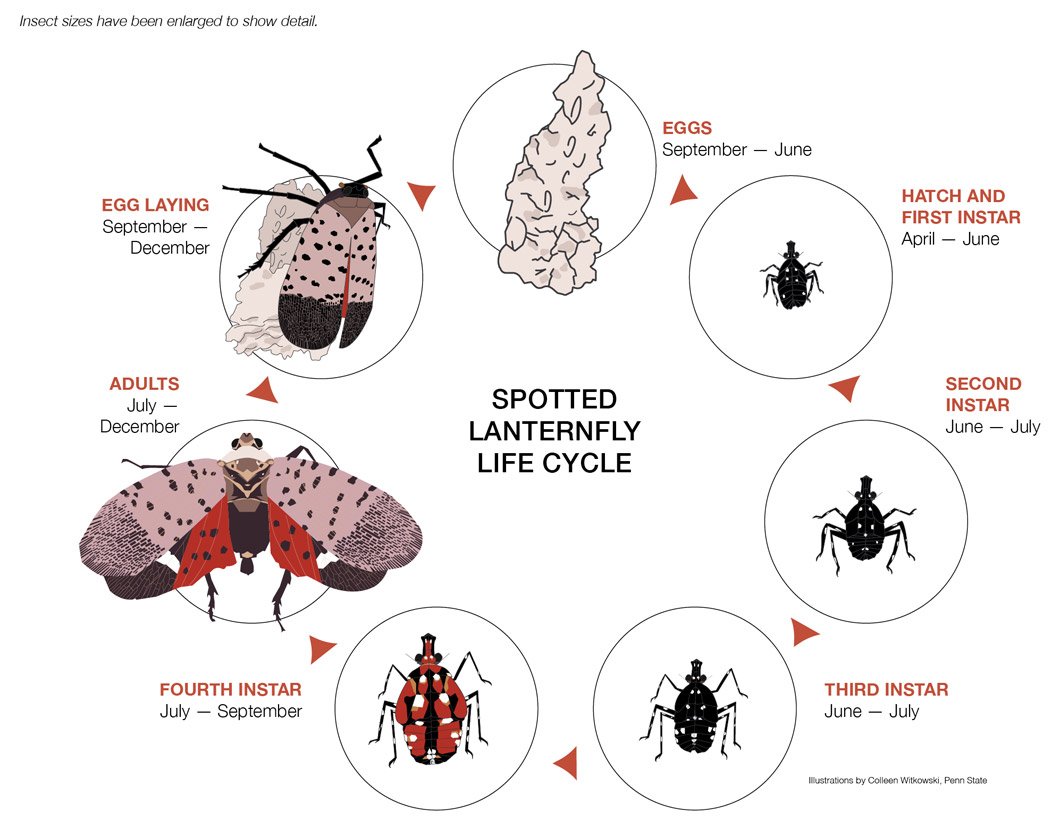
The Life Cycle of the spotted lanternfly.
Colleen Witkowski, Penn State, extension.psu.edu
Where It Is Now
The SLF likely arrived in North America hidden on goods imported from Asia. The first detection of the spotted lanternfly in the United States was in Berks County, Pennsylvania in September 2014. SLF has now spread throughout southeastern PA. Since first reported in 2014, spotted lanternfly has spread to multiple states, and interceptions of single adults have occurred throughout the Northeast, including in Connecticut, in 2018 and 2019. In 2020, two small established populations of spotted lanternfly were found in Fairfield county in Connecticut. SLF has also been reported in New York, New Jersey, Delaware, Maryland, Virginia, and West Virginia.
USDA APHIS has not placed a federal quarantine in any state as of yet, but warns that the spotted lanternfly could survive year-round on the farmlands, forests or urban areas of most states in the northeast part of the country. The Commonwealth of Pennsylvania updated an Order of Quarantine and Treatment as of March 2020 and the NYS Department of Agriculture and Markets has established external quarantines on areas with infestation.
To see a map of SLF sightings on Cornell CALS's page, select this link: Map of Confirmed SLF Sightings
Why the SLF Is of Such Concern to Connecticut
The SLF is an insect with a large and diverse host range. It feeds on about 60 genera of the trees and plants found in North America. In Connecticut, approximately 47% of the forest trees are considered as potentially susceptible to the SLF (See Tree List). Many of the fruit trees grown in Connecticut, such as apples, cherries, and peaches, are also considered to be vulnerable. Even if the insect does not kill the trees, it could destroy the value of the fruit. Grapes are likewise vulnerable. The impact on the agricultural industry of Connecticut could be devastating.
The degree of impact of the SLF on Connecticut's urban and rural forest trees is uncertain. It may turn out to be more of an annoyance with minor impact on forest health. However, there is the potential that it could cause much more significant damage.
Trees At Risk and How It Affects Trees
Both nymphs and adults of the SLF feed by sucking sap from the stems and leaves of host plants. Depending upon the severity, this can weaken and damage the plant by reducing photosynthesis.
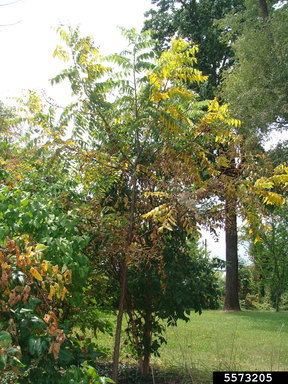
Spotted lanternfly damage on a walnut tree (Juglans nigra L.).
Eric R. Day, Virginia Polytechnic Institute and State University, Bugwood.org
Their feeding also creates a sticky, sugary residue called 'honeydew'. This honeydew attracts other insects and promotes the growth of a black mold called 'sooty mold', which can further damage the plant by blocking photosynthesis in the leaves of plants coated with the excrement.
The honeydew itself is sticky, unsightly and hard to get rid of which is why SLF poses such a problem to fruit farmers. The presence of the honeydew can destroy the value of the crop.
The invasive tree of heaven is the preferred host plant for SLF, but it also feeds on a wide range of crops and plants, including grapes, apples, hops, walnuts and hardwood trees. The potential range of hosts is one of the reasons why SLF is of such great concern and may be so difficult to combat. Altogether, there are about 60 genera of trees and plants that SLF is known to attack in North America. To date, states with heavy SLF infestations have only seen SLF kill sapling trees, sumac, grapevines, and tree-of-heaven. Healthy and established ornamental trees have not been recorded to have died from SLF, though canopy dieback and plant health decline has been observed.
The following are among the genera at risk from SLF:
- Almonds
- Apples
- Apricots
- Beech
- Black and paper birch
- Black gum
- Cherry trees and cherries
- Dogwood
- Elm
- Grapes
- Hops
- Linden
- Maple
- Nectarines
- Oak
- Peaches
- Pignut and shagbark hickory
- Pine
- Plums
- Poplar
- Sassafras
- Serviceberry
- Sycamore
- Tulip poplar
- Walnut
- White ash
- Willow
Indications that the SLF May Be Present
-
Direct Observation: SLFs group together in large numbers on hosts to feed, leading to large excretions of honeydew.
Depending on the time of year, a different life stage of the spotted lanternfly will be present.

PennState Extension
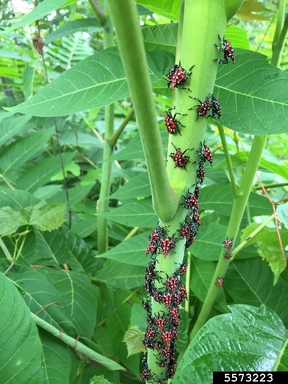
Immature spotted lanternflies feeding.
Emelie Swackhamer, Penn State University, Bugwood.org
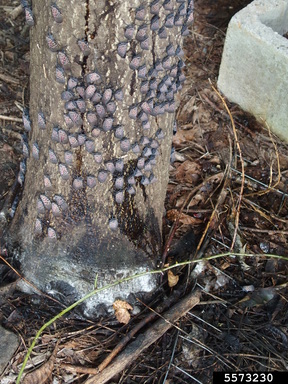
Adult spotted lanternflies feeding (appear darker in color when not flying and showing their colorful hind wings).
Emelie Swackhamer, Penn State University, Bugwood.org
-
Oozing: Plants ooze or weep and have a fermented odor. This comes from the wounds inflicted by the extensive feeding of the SLF.
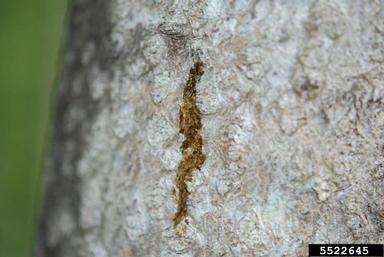
Weeping sap trail on tree.
Lawrence Barringer, Pennsylvania Department of Agriculture, Bugwood.org
-
Honeydew Buildup: Look for the buildup of large amounts of a sticky fluid (honeydew) on plants and on the ground underneath infested plants (note - other insects such as aphids also excrete honeydew).
-
Sooty mold: Black sooty mold coats the leaves of the plants.
-
Egg mass: Gray, clay-like at first, turns brown and cracked.
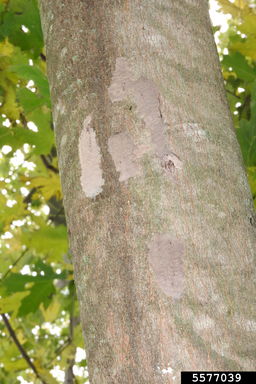
Spotted lanternfly egg masses on tree.
Richard Gardner, Bugwood.org
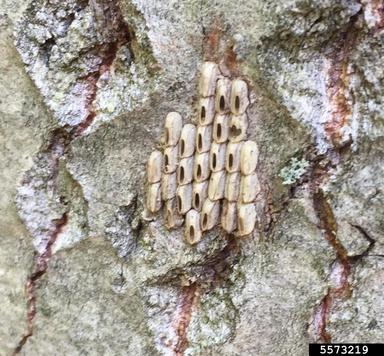
Spotted lanternfly old hatched egg masses on a trunk.
Emelie Swackhamer, Penn State University, Bugwood.org
What to Do If You Find SLF
First, and most important – if you think you have observed spotted lanternflies, do not attempt to move any wood or other potentially infested material from the site. Instead, you should:
- Report potential sightings of this invasive pest. If you suspect you have found a SLF, snap a picture of it and fill out this SLF Reporting Form.
-
Kill any spotted lanternflies you find immediately.
-
Follow these tips for dealing with spotted lanternflies.
-
Please check your vehicles for stowaways! Inspect your vehicles, trailers, and other items for SLF adults and egg masses when travelling through areas with known or suspected SLF populations. These insects are known to hitch a ride on vehicles and even clothing.
Additional Sources of Information
Connecticut Agricultural Experiment Station SLF Page
Connecticut Agricultural Experiment Station Pest Alert
New York State Integrated Pest Management SLF Page
PennState Extension Spotted Lanternfly Page
Pennsylvania Department of Agriculture Spotted Lanternfly Page
Content last updated in September 2024.

